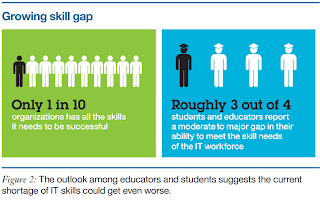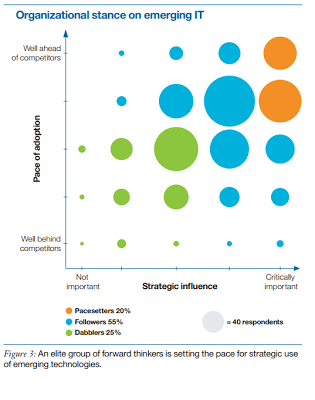IBM recently released the results of its 2012 tech trends study offering great insights into the tech world. The study explorers how enterprises are responding to the opportunities and risks introduced by new technologies.
IBM surveyed over 1,200 IT and business decision makers to determine why, when and how they adopt mobile, analytics, cloud and social business technologies.
One of the more notable finds is that there is a growing skills gap. In the four technologies studied, only 10% of companies stated that they had all the skills needed to be successful and one out of four reported major skill gaps. Three out of four students believed that the current shortage of IT skills could get even worse.
 |
| Source: The 2012 IBM Tech Trends Report |
Professor of Information Systems at Fordham University, Dr. Wullianallur Raghupathi stated: “Technology is changing so rapidly–not just upgrades, but dramatic changes in the discipline itself. Keeping pace is a challenge, not only teaching current technologies, but also forecasting and trying to guess what is coming down the pipeline.”
 |
| Source: The 2012 IBM Tech Trends Report |
IBM also asked the respondents to rate how important emerging technologies are to their business success and also their rate of adoption compared to their competitors. From this IBM were able to identify a small group of ‘pacesetters’ who move forward with technologies faster despite the barriers formed from adoption. They all use mobile, analytics, cloud and social technologies in more strategic ways.
IBM found that these pacesetters are more ‘Market-driven’, ‘Analytical’ and ‘Experimental’. What makes them more successful is the fact that they have a head start from all other companies. Instead of waiting until there is a business demand for new IT skills, ‘pacesetters’ start building skills ahead of time. IBM found that these companies are nine times more likely to experiment with technologies that don’t have a clear business application and they are twice as likely to develop skills beforehand to anticipate needs.
One of the finds also noted that the majority of companies are now using social media to engage with its customers. But the difference with ‘pacesetters’ is that they also use social media as a strong form of communication within the enterprise. This is also seen in cloud computing. Many companies are starting to adopt cloud but it’s the ‘pacesetters’ that are “more likely to have significant deployments of newer cloud concepts, like hybrid cloud and community cloud.”
Click here to read the full report: http://public.dhe.ibm.com/common/ssi/ecm/en/xie12346usen/XIE12346USEN.PDF
 Sarah Morgan
Sarah Morgan About the Author:
Sarah writes for Firebrand Training on a number of IT related topics. This includes exams, IT training, , IT certification trends, project management, certification, careers advice and the IT industry itself. Sarah has 11 years of experience in the IT industry.
Sarah writes for Firebrand Training on a number of IT related topics. This includes exams, IT training, , IT certification trends, project management, certification, careers advice and the IT industry itself. Sarah has 11 years of experience in the IT industry.

ليست هناك تعليقات:
إرسال تعليق